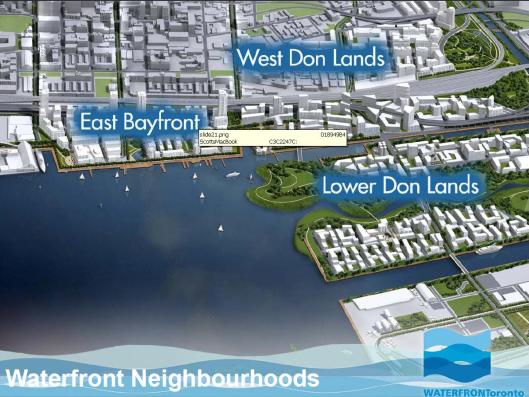By Nestor E. Arellano
Monorails, malls and Ferris wheels are getting all the press these days as numerous Torontonians choke on their mayor’s call for a revamp of the Toronto Waterfront project.

The Waterfront Toronto’s the current plan for the Port Lands which encompasses three neighbourhoods (East Bayfront, West Don Lands and Lower Don Lands), south of the city along Lake Ontario’s shores, calls for a mixed-use neighbourhood, and naturalization of the mouth of the Don River, expansive green spaces and affordable housing. It is a vision geared towards the service and needs of the city’s residents. The plan is one that has been gone through lengthy consultation with residents and has hailed by numerous urban planners.
On the other hand Mayor Rob Ford’s designs for the more than 174-hectares of lake front city lands focuses on attracting foreign investments for hotels, mega-malls, a monorail and a giant Ferris wheel. It’s a plan hatched by someone who prior to last year dismissed the waterfront development as a boondoggle.
It’s a bad deal if you ask me. And if you run a tech-based company hoping to win a procurement contract with the lake front development, it could be bad news as well.
If the Ford proposal’s aim is to raise money from the sale of the Port Lands to fix holes in the mayor’s budget, it’s not going to be much of a cash grab. The sale of some of these lands may be a one-time source for funding things such as property tax freeze but it will not be enough to solve the city’s structural budget problems.
The new plan will also likely bring far less tax revenue and development charges than what the original Waterfront Toronto plan would bring.

While Ford has complained that Waterfront Toronto is moving at snail’s pace, his plan could further delay projects for the area. Nearly a billion dollars has already been spent on soil remediation, infrastructure, planning, design and environmental assessments for the site. Ford’s scheme is so divergent from the original plan that it could necessitate a revised environmental assessment. Such a development would only add millions of dollars to cost of developing the waterfront and further delay and work in the area.
This would be unfortunate for many Canadian businesses hoping to snag a procurement contract with the water front development.
Planners hope to build some 12,000 residential units and more than 228,600 square meters of commercial space in the waterfront. The Waterfront Toronto’s iWaterfront Advisory Council, last year, estimated that this will create no less than 8,500 jobs in the clean tech and digital media space.
Planners estimate that as much as $32 billion would be spent on the entire project. About $1 billion of that will be spent on technology according to the Canadian Advanced Technology Alliance (CATA Alliance). The organization has been working hard to generate interest in the waterfront project among local information and communication technology (ICT) companies and SMBs.
According to CATA, one of the project’s primary objectives is to introduce sustainable practices and green technology.
Last year, the organization was very upbeat about the program. Will recent developments now endanger or delay these procurement prospects for local tech companies?
In a phone call yesterday, Barry Gander, executive director of the CATA Alliance, expressed concern over the possible loss of whatever gains that were achieved over the years of work in the waterfront if current plans are to be overturned. For instance he said, the laying down of fibre and Wi-Fi foundations that will enable future waterfront residents to access 1 gigabyte Internet speeds upon request is quite a feat for iWaterfront. Gander said fast broadband access will be key to the development of a “connected and smart” community in the area. “We wouldn’t like to see this compromised at all,” he said.
This, he pointed out, was achieved by getting the cooperation and funding from three levels of governments which is integral to the whole project. “This will all be destroyed if we were to go back to a single city development,” Gander warned.
“Toronto has to decide what kind of waterfront it wants. Do we want a Coney Island or do we want an integrated modern structure that was designed by the greatest city planners and architect of the world,” he said.
Nestor Arellano is a Senior Writer at ITBusiness.ca. Follow him on Twitter, connect with him on LinkedIn, read his blogs on ITBusiness.ca Blogs, email nestor at [email protected] and join the ITBusiness.ca Facebook Page.





